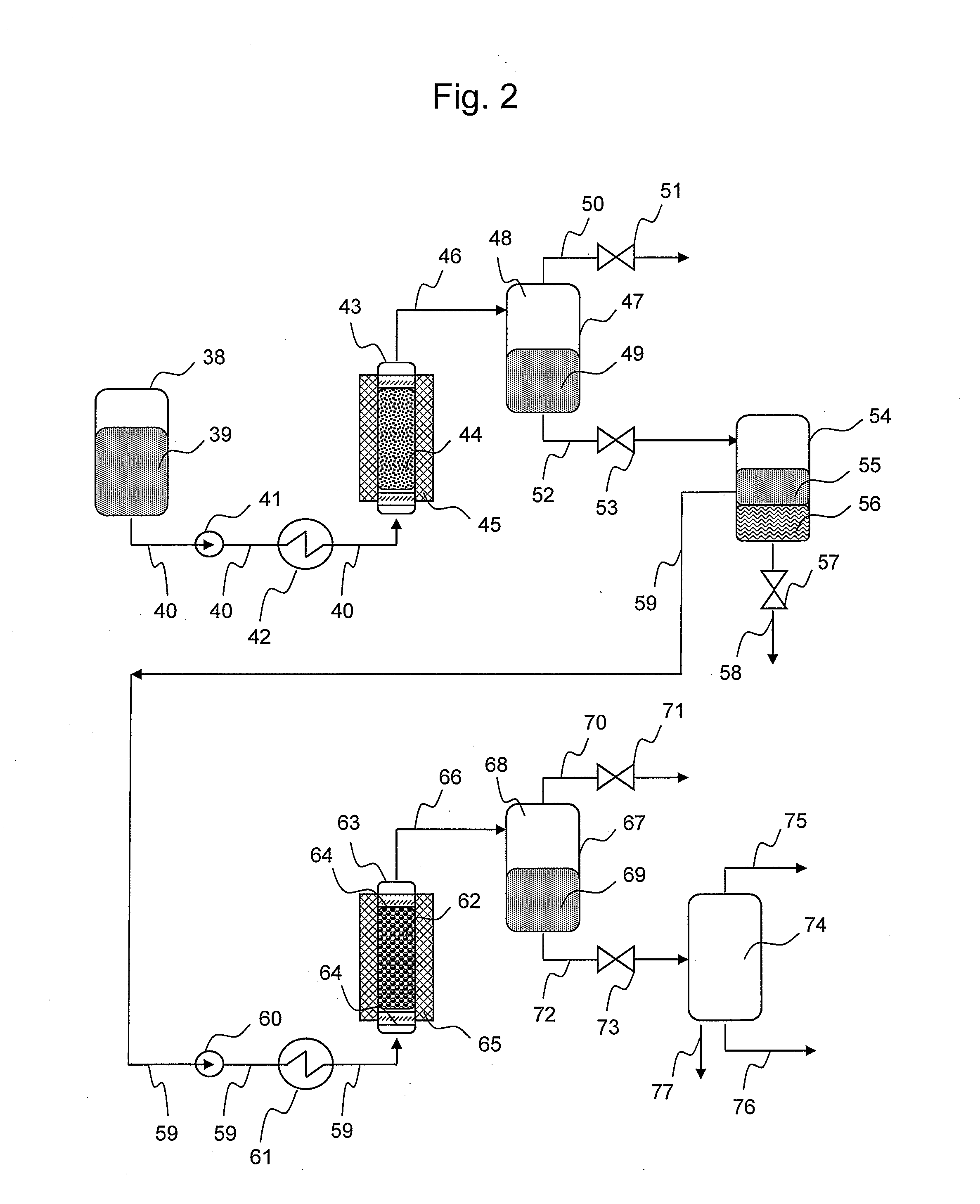Method for producing water-insoluble liquefied fuel oil from biomass
a technology biomass, which is applied in the direction of hydrocarbon oil treatment, sustainable manufacturing/processing, climate sustainability, etc., can solve the problems of low insufficient effect, and insufficient yield of liquefied fuel oil based on solid biomass content, so as to improve improve the yield of water-insoluble liquefied fuel oil. ,
- Summary
- Abstract
- Description
- Claims
- Application Information
AI Technical Summary
Benefits of technology
Problems solved by technology
Method used
Image
Examples
example 1
[0156]Oak wood was ground with a cutter mill and then dried. Subsequently, the dried product was passed through a 16-mesh sieve and then a powder that did not pass through a 32-mesh sieve (particle size: 1 mm or less) was prepared. This oak powder was further dried with a dryer and then adjusted to have a moisture percentage of about 15 wt %. A biomass liquefaction reactor was charged with 42 g (with a solid biomass content of 36 g and a moisture content of 6 g) of the oak powder (as a biomass feedstock) adjusted to have the aforementioned particle size and moisture percentage.
[0157]While xylene (Nakalai Tesque, a special grade reagent) for use as a solvent for liquefaction was transferred at a flow rate of 360 g / h via a high-pressure pump and an aqueous solution containing 5 wt % potassium carbonate was transferred at a flow rate of 84 g / h via another high-pressure pump, the solvent comprising xylene and an aqueous solution containing potassium carbonate was heated by a solvent hea...
example 2
[0167]A mixture (464 g) of 390 g of a water-insoluble liquefied fuel oil and 74 g of an aqueous phase obtained by a method similar to that in Comparative example 1 was allowed to pass at 100 g / h for 4.7 hours through a liquefied fuel oil dehydration reactor charged with 50 g of a zeolite catalyst H / ZSM-5 (Si / Al=45) while maintaining the reactor temperature at 300° C. and pressure at 5 MPaG. After dehydration, 386 g (83.2 wt %) of a water-insoluble liquefied fuel oil, 77 g (16.6 wt %) of an aqueous phase, and 1 g (0.2 wt %) of gaseous substances were obtained.
[0168]The components of the thus obtained water-insoluble liquefied fuel oil and aqueous phase were analyzed using a gas-chromatograph mass spectrometer (Shimadzu Corporation, GCMS-QP5000). The water-insoluble liquefied fuel oil was composed of 96.6 wt % hydrocarbons and 3.4 wt % oxygen-containing organic compounds. Therefore, 373 g (=386 g×96.6%) of hydrocarbons was generated, indicating that 13 g (36 wt %) out of 36 g of the s...
example 3
[0170]A mixture (464 g) of 390 g of a water-insoluble liquefied fuel oil and 74 g of an aqueous phase obtained by a method similar to that in Comparative example 1 was allowed to pass at 40 g / h for 11.6 hours through a liquefied fuel oil hydrogenation reactor charged with 20 g of a Pd / Al2O3 catalyst while maintaining the reactor temperature at 300° C. and the pressure at 9 MPaG. At this time, hydrogen was fed at 50 NL / h to the liquefied fuel oil hydrogenation reactor. After hydrogenation, 390 g (84.1 wt %) of a water-insoluble liquefied fuel oil, 72 g (15.5 wt %) of an aqueous phase, and 2 g (0.4 wt %) of gaseous substances were obtained.
[0171]The components of the thus obtained water-insoluble liquefied fuel oil and aqueous phase were analyzed using a gas-chromatograph mass spectrometer (Shimadzu Corporation, GCMS-QP5000). The water-insoluble liquefied fuel oil was composed of 97.4 wt % hydrocarbons and 2.6 wt % oxygen-containing organic compounds. Therefore, 380 g (=390 g×97.4%) o...
PUM
| Property | Measurement | Unit |
|---|---|---|
| temperature | aaaaa | aaaaa |
| temperature | aaaaa | aaaaa |
| temperature | aaaaa | aaaaa |
Abstract
Description
Claims
Application Information
 Login to View More
Login to View More - R&D
- Intellectual Property
- Life Sciences
- Materials
- Tech Scout
- Unparalleled Data Quality
- Higher Quality Content
- 60% Fewer Hallucinations
Browse by: Latest US Patents, China's latest patents, Technical Efficacy Thesaurus, Application Domain, Technology Topic, Popular Technical Reports.
© 2025 PatSnap. All rights reserved.Legal|Privacy policy|Modern Slavery Act Transparency Statement|Sitemap|About US| Contact US: help@patsnap.com


